Honors Transcripts for Homeschool Graduation


Transcript Sections
- Official Transcript
- Course Descriptions
- Resume
- DE Transcripts (colleges)
- AP & CLEP Reports
- SAT & ACT Reports
- Recommendation Letters
TO DO:
- Start Early
- Backwards Plan
- Find your state requirements
- Do Math Well
- Validate “Mom Grades”
- Consider College Credit
- Make it look official
How to write Homeschool high school Transcripts
Anyone can put together an amazing homeschool high school transcript for their son or daughter. I’m here to tell you exactly how so you can help them not only get into college but perhaps even with scholarship. Homeschoolers are more and more desirable by colleges every year.
This transcript package was drawn up for a Classical Conversations student, so it will be super useful to CC parents. But it can be edited for any homeschool program.
Things to keep in mind:
- Start early: Starting in 11th grade is good enough. You don’t need to send them anywhere until Fall of 12th grade, right? So, fall of 11th grade would put you months ahead of the game. Well, that’s not the entire point of transcripts. When we did ours, I found that having my daughter write a draft of her first resume was an eye-opener for her. She understood how important either volunteer or job experience was when she saw the blanks on the resume form, she needed to fill in.
- Backwards plan: I always try to imagine what my goal is before planning my year. And by that, I mean two goals: my year end goals and my graduation goals. I have curriculum forms I fill out each year and four-year high school course planning forms. Then I also slowly ween in college level courses as the student can handle them.
- State Requirements: Find your state’s minimum high school requirements and about four potential colleges’ freshman entry requirements. I might even choose a humanities degree and a STEM degree to set my child up to get in. The goal isn’t necessarily to know what they want to do at a young age, but to keep as many doors open as possible to them.
- Do Math well: I hear so many people say their kids don’t want to be an engineer or they don’t like math, so they will just pick a job that doesn’t require it someday. To that I just want to relay some stats.
- Since 1990 (I graduated high school in 1994) employment in STEM occupations has grown 79% – increasing from 9.7 million to 17.3 million. Per Pew Research Center. To give less effort to math training is to close millions of doors for our students. You may think they won’t want to go in that direction, but don’t close the door for them. Make them do math well.
- The US placed 30th of 64 countries in math according to the Program for International Student Assessment (PISA). It’s hard to say we can’t do better and shouldn’t do better. Homeschoolers should be the leaders for this.
- 74% of middle school girls express an interest in engineering, science, and math… yet the industry still sits around 10% women. This is cultural. We can do better. Homeschoolers again, should be leaders here. Moms, tell your girls they CAN. They need to hear it from YOU.
- 2 out of 3 women say they were not encouraged to pursue a career in STEM. If you haven’t yet told your daughters they are capable and maybe even exceptional candidates for a STEM job, consider doing so. She can.
- Women make up about 18% of computer science undergrads. Cyber security is a highly rewarding career where women would benefit from knowing they helped millions of people stay safe from cyber harms. It is a “helping” field just like nursing and teaching.
- Women make up 50% of the college educated workforce, but just 27% of the STEM workforce. Independence and confidence in adulthood comes from being able to support herself and her family. Yes, she can get married and stay home. But, with high pay comes more flexibility in life. She will be able to care for more people if a time came that she needed to.
- 63% of middle school girls who know women in STEM feel powerful doing STEM. If your daughter can find just one STEM mentor, she will be more likely to do something in this area. (Stats from idtech, April 23, 2021)
- Align with some organizations that will validate your “mom grades”. A few college courses will do this if they get A’s or B’s in them. We also used Center for Talented Youth courses for our gifted daughter. Math programs that give grades do that too. We used Art of Problem-Solving online courses that assigned automatic grades. Use anything you want, but one or two grades from outsiders will not only validate your grades but will also teach your student how to manage grades before they get their first heavy college load.
- College Credit: learn about AP, CLEP, and Dual Enrollment. All three are valuable and have their own pros and cons.
- Official: Make it look official and professional. Keep it to two pages.
Timeline
Middle School:
- make a four-year plan of courses (using your state requirements and college freshman entry requirements) and start to choose curriculum. You’ll need to be sure their middle school curriculum prepares them for their high school curriculum. This is backwards planning.
- If you are going to use any middle school courses for high school credit, be sure they are a high enough quality and time commitment.
- Save syllabi, course catalogs, and receipts for materials purchased for high school courses. You’ll be using the information from these to detail out your transcript and course description page.
- Brainstorm course names. This can be an art form. “Honors English 9” versus “Honors Literature and Composition I”.
- Know that once you get to college courses, you’ll be speeding up the high school process since one high school credit takes a year, while one college credit only takes one semester.
- Make a GPA calculation standard for your homeschool. All public schools are unique in this, and you can be as well. Try to make it simple and easy to understand so admissions are impressed by the student and their efforts and isn’t thinking only about how to read the chart.
9th, 10, and 11th grades:
- Update data as you go along.
12th grade:
- Order diploma from HSLDA (or elsewhere).
- Update data to current date each time you need to send it out. Future grades should be listed as TBD.
- Sign and notarize after completed. This may be well after graduation as you’re awaiting college dual enrollment grades to come in. AP tests don’t come in until the end of the summer after senior year as well. College Board AP and CLEP paperwork as well as DE transcripts should all be part of the transcript package.
- Package includes:
- Official transcript
- Course description pages
- Resume
- DE transcripts from any colleges
- College Board AP and CLEP reports
- SAT / ACT score reports
- Two recommendation letters from teachers or coaches (not family)
- Consider how to maintain:
- Electronic file carefully named so as not to get lost digitally.
- Hard copy saved in a file along with any important high school documents and diploma. Perhaps have Mom, Dad, and student all keep a hardcopy in separate files somewhere.
Download Customizable Transcript Package


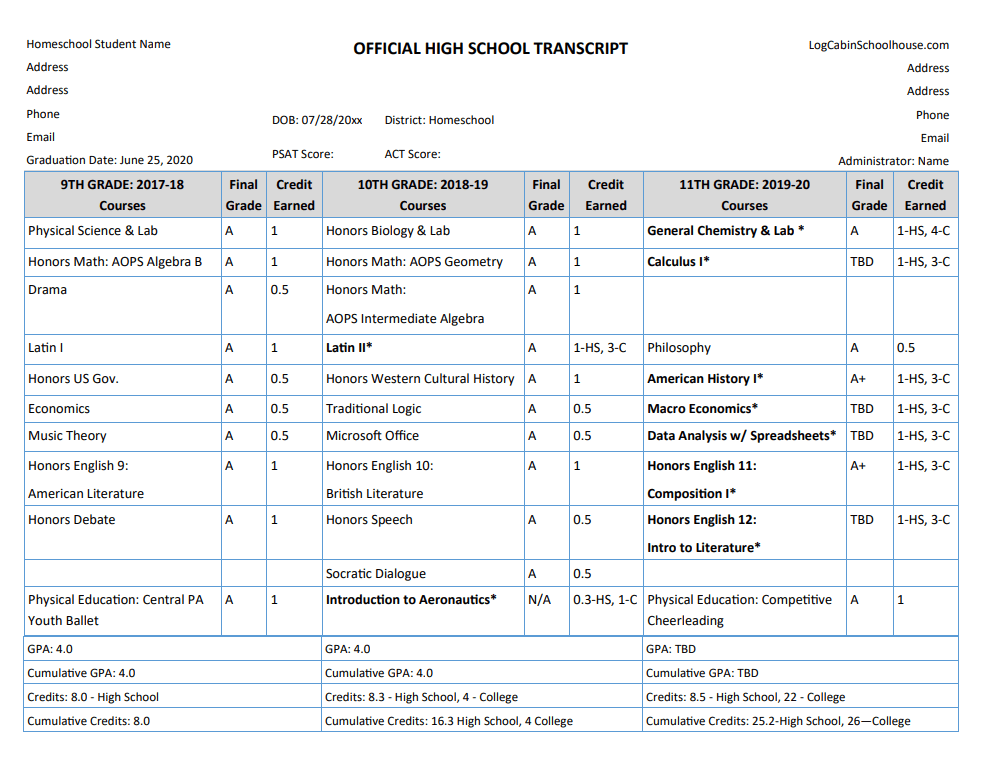


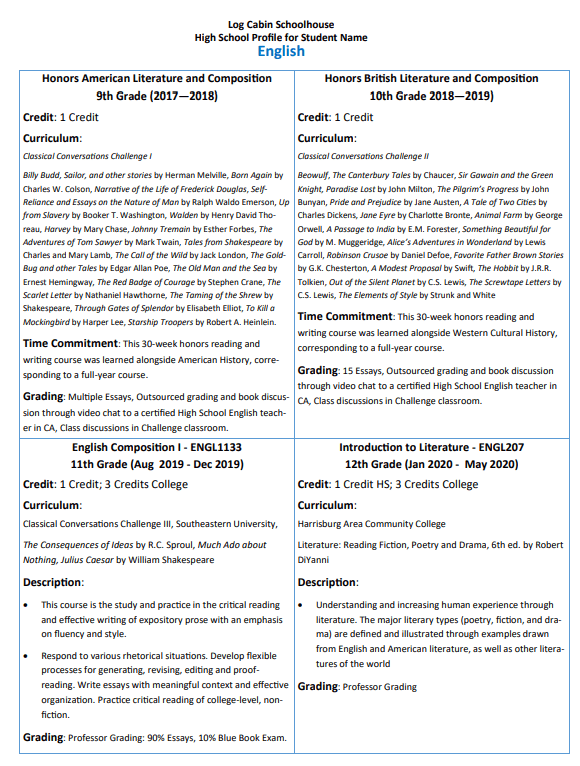
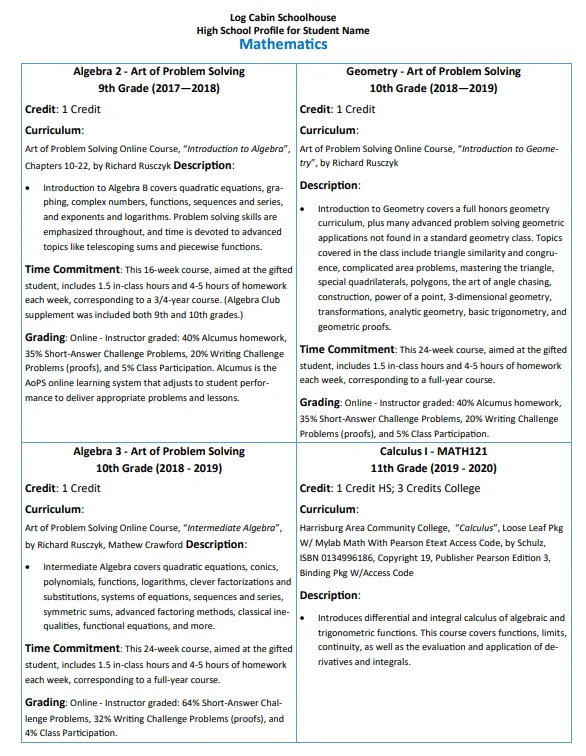
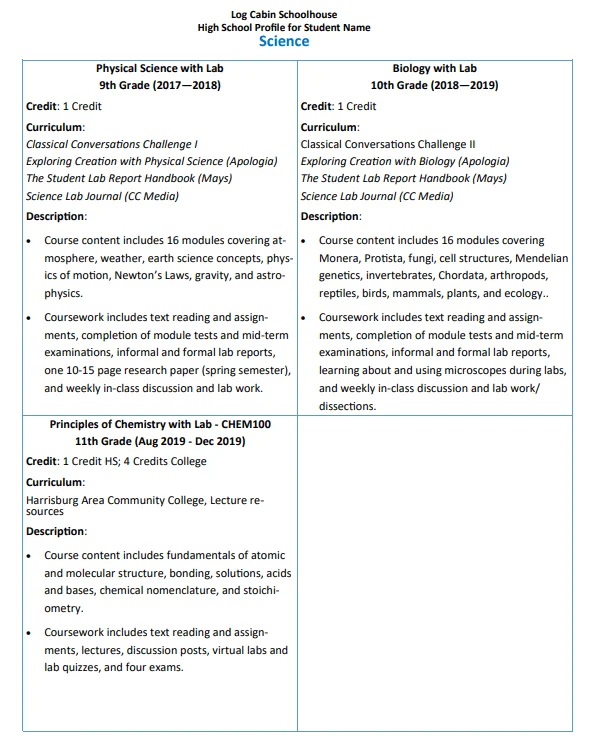

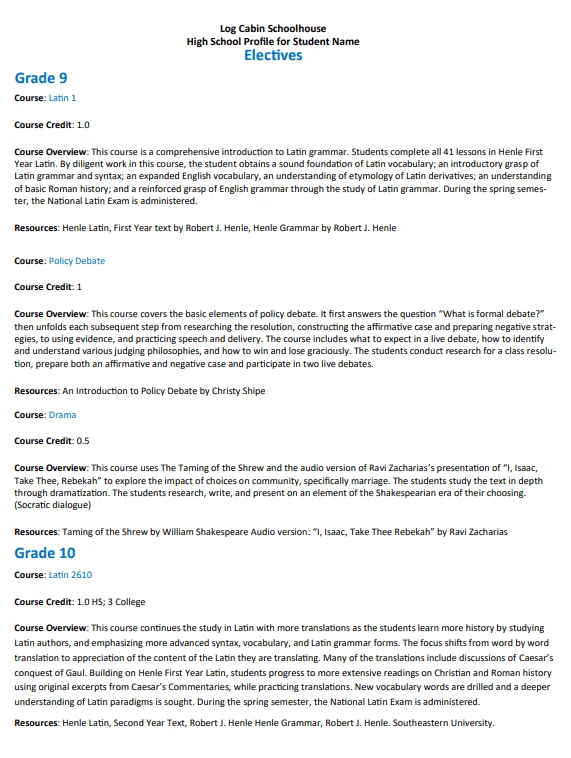




You must be logged in to post a comment.